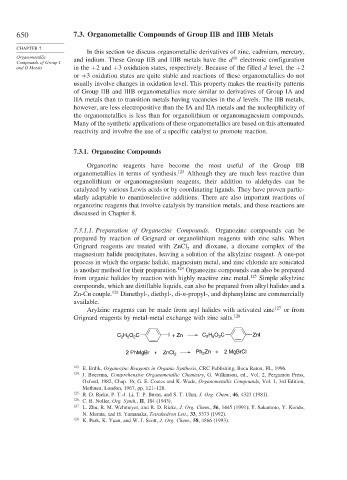Page 675 - Advanced Organic Chemistry Part B - Reactions & Synthesis
P. 675
650 7.3. Organometallic Compounds of Group IIB and IIIB Metals
CHAPTER 7
In this section we discuss organometallic derivatives of zinc, cadmium, mercury,
Organometallic 10
Compounds of Group I and indium. These Group IIB and IIIB metals have the d electronic configuration
and II Metals in the +2 and +3 oxidation states, respectively. Because of the filled d level, the +2
or +3 oxidation states are quite stable and reactions of these organometallics do not
usually involve changes in oxidation level. This property makes the reactivity patterns
of Group IIB and IIIB organometallics more similar to derivatives of Group IA and
IIA metals than to transition metals having vacancies in the d levels. The IIB metals,
however, are less electropositive than the IA and IIA metals and the nucleophilicity of
the organometallics is less than for organolithium or organomagnesium compounds.
Many of the synthetic applications of these organometallics are based on this attenuated
reactivity and involve the use of a specific catalyst to promote reaction.
7.3.1. Organozinc Compounds
Organozinc reagents have become the most useful of the Group IIB
organometallics in terms of synthesis. 123 Although they are much less reactive than
organolithium or organomagnesium reagents, their addition to aldehydes can be
catalyzed by various Lewis acids or by coordinating ligands. They have proven partic-
ularly adaptable to enantioselective additions. There are also important reactions of
organozinc reagents that involve catalysis by transition metals, and these reactions are
discussed in Chapter 8.
7.3.1.1. Preparation of Organozinc Compounds. Organozinc compounds can be
prepared by reaction of Grignard or organolithium reagents with zinc salts. When
Grignard reagents are treated with ZnCl and dioxane, a dioxane complex of the
2
magnesium halide precipitates, leaving a solution of the alkylzinc reagent. A one-pot
process in which the organic halide, magnesium metal, and zinc chloride are sonicated
is another method for their preparation. 124 Organozinc compounds can also be prepared
from organic halides by reaction with highly reactive zinc metal. 125 Simple alkylzinc
compounds, which are distillable liquids, can also be prepared from alkyl halides and a
Zn-Cu couple. 126 Dimethyl-, diethyl-, di-n-propyl-, and diphenylzinc are commercially
available.
Arylzinc reagents can be made from aryl halides with activated zinc 127 or from
Grignard reagents by metal-metal exchange with zinc salts. 128
H O C
C H O C I + Zn C 2 5 2 ZnI
2 5
2
Ph Zn + 2 MgBrCl
2 PhMgBr + ZnCl 2 2
123
E. Erdik, Organozinc Reagents in Organic Synthesis, CRC Publishing, Boca Raton, FL, 1996.
124 J. Boersma, Comprehensive Organometallic Chemistry, G. Wilkinson, ed., Vol. 2, Pergamon Press,
Oxford, 1982, Chap. 16; G. E. Coates and K. Wade, Organometallic Compounds, Vol. 1, 3rd Edition,
Methuen, London, 1967, pp. 121–128.
125
R. D. Rieke, P. T.-J. Li, T. P. Burns, and S. T. Uhm, J. Org. Chem., 46, 4323 (1981).
126
C. R. Noller, Org. Synth., II, 184 (1943).
127 L. Zhu, R. M. Wehmeyer, and R. D. Rieke, J. Org. Chem., 56, 1445 (1991); T. Sakamoto, Y. Kondo,
N. Murata, and H. Yamanaka, Tetrahedron Lett., 33, 5373 (1992).
128
K. Park, K. Yuan, and W. J. Scott, J. Org. Chem., 58, 4866 (1993).

